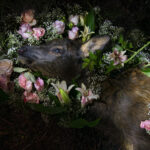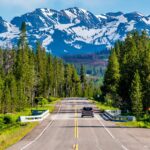Researchers are changing the ways we see, think about, and manage our roadways
By Kristen Pope
“People don’t really think about this impact that roads have because roads and cars are such an important part of our life in North America,” says Western Transportation Institute (WTI) senior research scientist Tony Clevenger. “We’re an automobile nation, and we often go from Point A to Point B and [don’t] think about the impacts that a six-lane highway will have on mule deer that are trying to migrate across.”
Roads take up less than 1 percent of the landscape in the United States, but they have a disproportionate ecological impact, affecting up to 20 percent of the landscape. Researchers who specialize in the relatively young field of road ecology study those impacts, and their findings are changing the way we think about roads and informing ways to mitigate the negative side effects of roads. WTI is a leader in this research.
As the field of road ecology has emerged and become established, it makes us see roads not just as transportation corridors, but also as structures that change and influence surrounding landscapes. “The environment doesn’t end at the road edge,” Clevenger says. Now we are learning how to minimize the damaging impacts.
It all starts with research. The field covers everything from studying roads’ impacts on wildlife—including large mammals, amphibians, reptiles, and fish—to plants, air quality, water quality, and even noise and light pollution from headlights. Road ecologists examine topics like carbon emissions, chemicals from deicing agents, heavy metals’ impact on wetlands, the dispersal of exotic plants along roadways, ways to reduce erosion after construction, and even how to utilize right-of-ways to fight climate change.
For decades, the subject was scattered among other disciplines, with papers on related topics appearing in engineering, wildlife, and ecology journals, as well as publications from transportation safety institutes. However, around 25 years ago, the discipline became more cohesive, and people started publishing books about road ecology as its own field of study.
WTI, one of many university centers around the country conducting transportation research, was among the first to focus on rural transportation issues, from road ecology and creating safer wildlife crossings to public transportation in rural areas. Founded in 1994, WTI began as a joint effort of the Montana and California Departments of Transportation and Montana State University, and it is now based in Bozeman, Montana. The institute has 30 staff members, with a road ecology team made up of two civil engineers and three ecologists; they also work with around 15 professors. One computer science professor is helping develop a smartphone app for roadkill data collection, while a civil engineering professor is designing a bridge, and ecology professors specializing in bees and butterflies are assisting with a roadside pollinator study. WTI works on a variety of projects in North America in locations such as the Canadian Rockies, Montana, Alaska, and California. The institute’s experts also share their expertise with planners around the globe, conducting workshops and otherwise collaborating on projects in Mongolia, India, Nepal, Malaysia, Kenya, Borneo, and beyond.
One of the biggest dilemmas in road ecology is protecting humans and animals from wildlife-vehicle collisions. Every year, between one and two million large animals collide with vehicles in the US, according to a 2008 study by the Federal Highway Administration. Many of WTI’s projects involve wildlife crossings, and the road ecologists work to tailor each design to local species. It can be challenging to find the right type of crossing that animals will actually use, will be safe for the animals, and will be usable for as many species as possible.
“Different species may have different needs,” WTI road ecology program manager Rob Ament explains. “How big do [structures] have to be? What do the approaches to the structures have to look like? What kind of fencing do you use for elephants or tigers? Do they like underpasses or overpasses?” In one project in Asia that WTI collaborated on, old fire hoses were twisted and strung above roadways to provide primates and other species with a safe aerial crossing.
Another WTI project in Montana placed around 40 Denil fishways (fish ladders) to connect aquatic habitats in order to help boost the Arctic grayling population, which was declining. The researchers are working to see if retrofits of the fishways will allow the Arctic grayling to pass with less water. They are also looking at ways to analyze how small animals—including amphibians, reptiles, and terrestrial mammals—can cross roads. They are compiling case studies and synthesizing the information in order to find the best ways to reduce mortality on the roadways.
Crossings aren’t the only way to keep wildlife off roads. WTI senior research ecologist Marcel Huijser is studying systems that can work for animals with paws the way cattle guards work for animals with hooves. He is working on a project involving electrified barriers to keep wildlife off roadways in areas such as fence end gaps and access roads—locations where cattle guards are sometimes used. “Where these wildlife guards, cattle guards, don’t do a good job is with regard to species with paws, mostly carnivore species. Think bears, wolves, bobcats, coyotes,” Huijser says. Huijser and collaborators are testing electrified barrier designs on a melon farm in northern Montana that is a magnet for black bears—previously half a dozen bears could be seen feasting on melons at a time. He says after a few modifications, the designs are working well.
Branching out from wildlife crossings, another WTI project studied wool erosion control blankets and other wool-based products for roadside reclamation projects. Transportation departments must mitigate soil erosion and surface runoff after projects to allow vegetation to reestablish, and the team examined whether wool products, which are commonly used in New Zealand, may be a good solution. They tested three different types of biodegradable wool products for erosion control and compared them to products already commonly used in the US such as straw and coconut blankets, woven plastic silt fence, and wood fiber compost. They found promising results for the wool products—which fertilize as they degrade—and are working to develop and optimize them for potential use
WTI also explores opportunities to use roadside right-of-ways for purposes like carbon sequestration and solar power. One project focused on ways to increase carbon stocks in right-of-ways in Montana. They tried mowing with a higher blade to leave taller grass, planting shrubs, disturbing the soil, and adding legumes to the seed mixes they applied. They found minimizing soil disturbance was the best way to increase carbon storage potential. “It’s important to think of [right-of-ways] ultimately as an asset to manage, not just as a cost for transportation agencies to have to mow and control for the spread of noxious weeds,” says Ament, WTI’s Road Ecology Program Manager.
Roads are a powerful part of the ecosystem that can have a big impact. Work by road ecologists and institutes like WTI is helping us understand the many ecological impacts our roads cause and come up with creative ways to address those impacts and reduce the negative effects of roads.
Kristen Pope is a freelance writer and editor. Learn more about her work at kepope.com.


